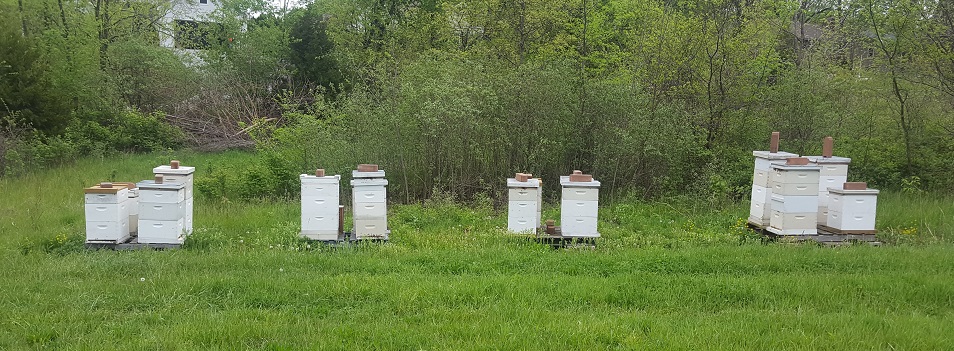HONEY
Honey is flower nectar collected and brought back to the hive when and it’s about 80% water. The bees cure the nectar to around 18% moisture in the hive and then cap the beeswax comb with more beeswax to preserve it for future consumption. At that low moisture level sugars act like salt as a preservative and inhibit bacterial or fungal growth. That’s why honey may crystalize but never go bad. There are normally minor honey flows in early Spring that are used to get the hive up to full strength (+/-80,000 per strong hive) for the heavy flow that normally starts early June and ends in early to mid-July. Bees are the only known insects that hoard resources so they will continue to gather honey as long as nectar is available. As the beekeeper you harvest only the surplus normally leaving 80 pounds per hive for them to consume over the winter to make warmth.
We harvest twice a year. Once over July 4th weekend and again over Labor Day weekend. The first harvest is normally lighter in color, more delicate in flavor, and is predominately from various types of clovers hence why it’s call “Sweet Clover.” The 2nd harvest is normally darker and more robust in flavor and comes from a myriad of wild flowers. However, this is not always true. No harvest is the same as weather patterns influence respective plant activity and thus respective flower and nectar production.
When we harvest honey, we get frames of capped honey and uncap them by pulling the caps off the cells. We then run the frames through a radial extractor (imagine a huge centrifuge) that slings the honey out of the comb without damaging the comb. The honey drains out of the extractor onto a screen that filters out small bits of wax and things from the hive. It’s then poured through another screen covered in cheese cloth into a holding tank where fine bits of wax are removed and air bubbles are allowed to dissipate.
This is where our honey differs again from many store bought brands. To keep honey from crystalizing on the shelf large producers heat the honey above 130 degrees and push it through a micron filter that removes all of the microscopic pollen. This heat destroys natural enzymes that enhance the flavor. The removal of the pollen slows crystallization but this too removes some of the floral notes and all of the pollen benefits. Raw honey is more prone to crystallization because of this but crystallization is completely normal and can be reversed easily by gently warming the container of honey in a warm pot of water for an hour or two depending on how large the container is and how crystalized it is.
When you look at the label of most store bought brands there make note of where the honey came from. Many times it’s a mix of regional and imported honeys, so you really don’t know where it came from. All honey sold in in our stand is 100% Local, raw, and pure but when we run out, it’s 100% gone.
Comb Honey
It’s a little tricky for the beekeeper to get them to effectively make but it’s well worth the effort if it’s done right. It’s as raw as you can get as it’s merely pulled out of the hive, cut to size, and boxed up for sale. How do you eat it? Slice it about ½ an inch thick and lay it on a warm biscuit. Cut it in a 1 inch cube and stick a tooth pick in it as a unique sweet offering at a dinner party. Anywhere honey is used you can use comb. There’s little as unique to the pallet as eating comb honey.
What do you do with the wax when you’re chewing it? You can spit it out or swallow it. If you swallow it it’s a very high quality, 100% natural, non-soluble dietary fiber. When eaten on a biscuit or with other things the wax is unable to reform as a mass and is hard to even notice.
Chunk Honey
Chunk honey is a chunk of fresh comb honey floated in fresh liquid honey. It allows someone to try honey in both comb and liquid form. It’s quite a treat that can also make for a very unique gift.
